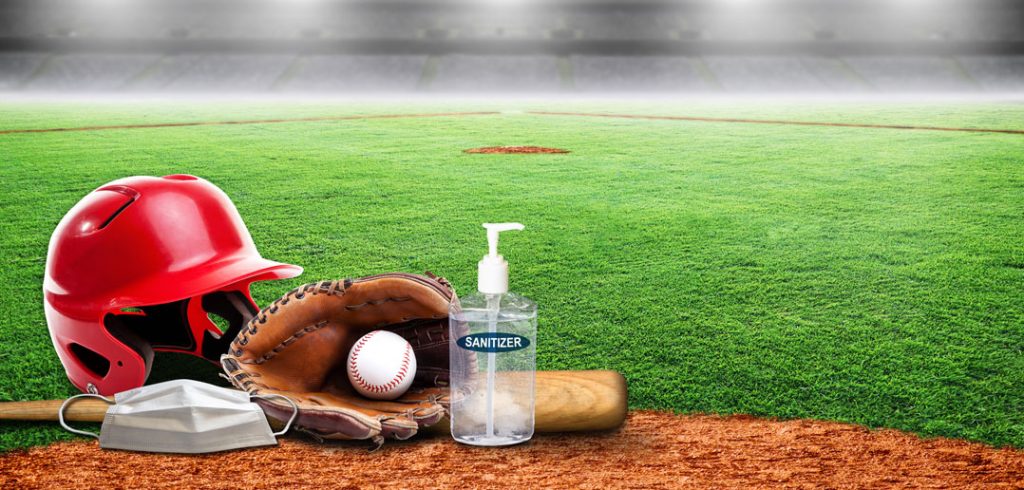For many, March 11 was the day the coronavirus pandemic hit home. That was the day the NBA announced it was suspending its season after Utah Jazz center Rudy Gobert tested positive for COVID-19, just minutes before the team’s game.
Over the next several months, the entire sporting world was thrown into flux. March Madness was canceled. The MLB season was pushed back. The NFL draft was conducted remotely. NBA and NHL players went into “bubbles” to finish their seasons. Even as games and matches returned, no fans were allowed in the stadiums.
According to an ESPN analysis, an estimated $12 billion in sports revenue and hundreds of thousands of jobs were lost due to the COVID-19 shutdowns. While some of those revenues have started to come back with sports resuming, it could take a while for things to return to normal, said Mark Conrad, director of the Gabelli School sports business concentration and associate professor of law and ethics.All of this will have significant impact, both short-term and long-term, on franchises, colleges, and communities that rely on sports, he said.,
“The question is when and how will (sports with fans) come back, and that may take time,” Conrad said. “It’s still going to take months and months to get back to any semblance of a pre-COVID state. I think 2021 could easily also be rocky, and I think realistically for sports, 2022.”
Professional Revenue Fallout
Conrad said that he believed MLB and the NHL would be the most affected by the lack of fans in the stadiums.
“In the NHL’s case, estimated revenues will be down probably at least 40%, if not more, because of the lack of gate receipts,” he said. “It’s a very [ticket]-dependent league. I think baseball’s fairly similar. The NFL is probably the best equipped to survive [limited or no fans]… because of their very, very lucrative television contract.”
The loss of revenue this season could impact future seasons and players’ contracts due to its effect on the salary cap, Conrad said. He projected that salary caps would either stay the same or go down, which could impact salaries for players who are free agents. The NHL’s players union tried to mitigate these losses by signing to a new collective bargaining agreement that limited how much the salary cap could go down, Conrad said.
“On the owners’ side, I think for the first time that I can remember, franchise values could go down,” he said.
Outside of the teams themselves, sports also provide jobs and economic impact to the surrounding communities. Without fans, many neighborhood businesses, such as those around Yankee Stadium, are taking a hit, Conrad said.
“There are establishments around Yankee Stadium that are very dependent on the games,” he said. “They would be hurt as well as the employees in the stadium—those who sell the popcorn, the drinks, and do the concessions.”
Larger-scale events, such as tennis tournaments or marathons, usually serve as a tourism boom for the cities they’re located in. But without fans this year, that’s another loss, Conrad said.
“Without fans going to the U.S. Open Tennis Tournament, that’s a huge hit,” he said. “I think you can say the same thing about the New York City Marathon, because that’s a very big event in terms of people coming to the city and that’s not happening this year.”
Effect on College Sports
For colleges and universities that rely on athletics as a large revenue source, this year will be particularly tough, Conrad said, as some leagues have canceled the fall season and others have barred fans or reduced capacity. The Atlantic 10 and Patriot League, the two conferences Fordham competes in, both canceled their fall seasons, with the hopes of playing those sports in the spring.
While some conferences, have postponed their lucrative college football season, others, including the SEC, ACC, and Big 12, are adapting their schedules, including limiting out-of-conference play. The Big 10 had previously announced it would not play in 2020, but after facing pressure from coaches, players, fans, and even President Trump, the conference announced on Wednesday it would try to restart the college football season in late October.
Still, some schools are already cutting “less lucrative” athletic programs in response to revenue losses from the pandemic, he said. Stanford University announced in July that it would cut 11 of its varsity sports programs.
Looking Ahead
Despite the challenges, Conrad said he believes fans will “be running back” so long as the teams can help make them feel safe.
“I think we’re going to have to think about how we produce the events, the safety measures for the future,” he said. “I think you will have temperature checks done more. I think there will be other types of screening, whether it’s going to be for COVID or any other kind of viruses.”
Conrad said that some things will be altered, such as how food is distributed and mask usage.
“This idea of grabbing into food, touching, the smorgasbord idea, I think that’s going to be out,” he said. “Masks could still be with us, and that’s not a bad thing. In the winter, I think it would be very effective.”
The way fans watch games will also be likely to change, now that producers and directors have been able to experiment without people in the stands.
“We’re seeing many more camera angles now coming in to make up for the loss for fans, [and]there’s also more room in the arenas,” he said. “Artificial intelligence or virtual reality situations—I think you’re going to see those growing as ways to watch sports.”


